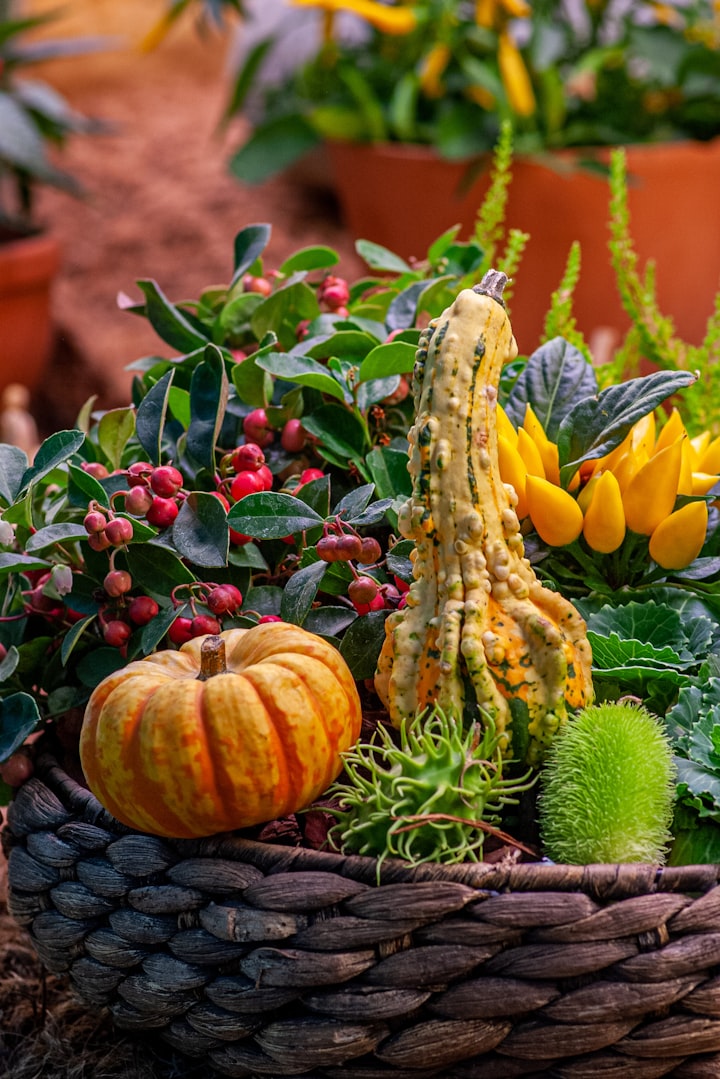Preparing Your Garden for Winter
Tips for Winterizing

The signs are all there. The trees are beginning to put on a brilliant show of colors. There's a chill in the air. Pumpkin spice infused food and drinks are everywhere you turn. Yup, that's right, it’s time to winterize your garden.
Winterizing your garden is one of the most important parts of preparing your flowers, vegetables and shrubs for the next growing season.
But where do you begin? Which plants should you bring inside for winter, and do you need to turn off an irrigation system? Can your woody plants withstand the cold? And most importantly, when should I start winterizing my gardens? Winterizing can seem daunting. Here a tips to get your gardens and shrubs ready for the cold months ahead.
Know your USDA plant hardiness zone
The best time to start winterizing gardens is after the first hard freeze in the fall. The USDA determines plant hardiness zones by calculating the average annual extreme temperature over the past 30 years. Keep in mind that these zones do not calculate the lowest temperature the zone has ever had, nor does it predict the lowest temperature occurring in the future.
You will want to know how to best protect your growing plants from a frigid winter based on where you live. If you live in the colder zones to the North, you may need to develop a more ardent winterizing strategy than someone living in a warmer plant hardiness zone. A sudden drop in temperatures can kill or damage your more sensitive plants, and it’s always better to be proactive than reactive when it comes to caring for a garden.
The hardiness zone where you live will decide which plants you bring inside, whether you cover your shrubs with landscape fabric and which bulbs you decide to grow this year.
Review the Success of the Growing Seasons
Before planting any new fall or winter bulbs, consider how this year’s growing season went. How did your perennials do? Are the annuals worth replanting every year? Take note if you felt a particular plant was too much maintenance, or if a flower bed didn’t bloom the way you thought it would.
Revisiting your successes and those that went wrong will give you a better attack plan for winterizing your garden. You’ll know which plants to throw out and which to keep, and the better you feel about the garden, the more you’ll enjoy maintaining it, and the healthier and more beautiful it will be.
Know Which Plants to Remove & Which to Leave
Annual flowers, such as marigolds and petunias as well as some vegetables, won’t be returning on their own. Annual plants grow for one season. , perennials like hydrangeas and day lilies typically return for growing seasons without needing to be replanted.
While you may want to avoid removing spent vegetables and flowers, this can invite pests and disease. bacteria and pest eggs can overwinter in debris, and they will take over your healthy plants once spring arrives.
A good rule of thumb when cutting back plants for winter is that if the plant blooms on new growth, it can be pruned in winter, before the new season's growth begins and after the final bloom of the year. Be careful with spring-blooming shrubs—those can't be pruned in winter without damaging the flower buds and ruining the blooming season.
Clean Out the Weeds & Plant Debris
To help make sure no harmful elements fester in your garden, clean up all plant debris in the vegetable garden and flower beds.
Clean out dead leaves, plant parts, and any invasive or diseased plants. Pull out any plant you suspect might be infested with bugs, didn't grow well, or had an odd coloring. You don’t want those plants to continue invading your garden or spreading their ill will throughout the area. Dead plants, old fruit, and vegetables and any diseased plants should be removed from the garden beds and disposed of. If the spent plant material was healthy it can be composted, if the plant material showed signs of disease, it should be disposed of in the trash or by being burned.
Some gardeners will clear their veggie plants and cut back their perennials. While other gardeners may choose to leave some perennials for winter interest. Cornflowers and ornamental grasses look beautiful covered in the snow, plus they add extra food .
Turn Out the Soil
Whatever the size of your garden, it's good to turn out the soil, bring up any plant roots that might have been missed, turn under any remaining plant material, there's always some, so that it has a chance to decompose. Layer fallen tree leaves in the garden bed and turn under the soil.
You could also dig trenches in the garden, pile in the leaves and compost and cover with soil. These organic soil amendments will decompose over winter and leave the soil more fertile when spring rolls around.
Removing old roots from the soil can allow for more nutrients for new plants. Old roots, even if the plants are removed, may stay alive and still be drawing nutrients from the soil. In some cases, new plants may even shoot up as the roots are still alive.
Bring Tender Plants Inside
Some plants can withstand a drop in temperatures or are protected underground from cold frosts. Winter flowers, like English primrose, violas, and camellia, will do fine in your winter landscape. Even some vegetables such as carrots are incredibly winter-hardy and can stay in the garden through the coldest temperatures.
You will want to bring succulents, potted flowers, and tender bulbs inside. A frost or sudden drop in temperatures can shock and kill these types of plants. The plants or bulbs you bring inside as houseplants will depend on the zone you live in and the plant’s cold-hardiness.
gardeners will also move their favorite annuals indoors this time of year as well. Whether they make it through to spring is a bit of a gamble, but if you have the space, it doesn’t hurt to try. When bringing annuals inside remember to cut back, keep dry, and store in cool, bright conditions. They aren’t going to bloom indoors, but the idea here is to keep them alive. This is best for experienced gardeners or those with cool, bright porches or a greenhouse.
Care For Your Bulbs.
times, gardeners have trouble planting bulbs. You need to plant them in a hole inches deep, in most cases, so it has good protection over winter and is ready to bloom in spring.
To protect any vulnerable bulbs and tubers from frost, remove them from the ground and dry them. Storing moist bulbs may lead to rot. Dry them on trays in a protected area such as a garage or tool shed (make sure temperatures aren’t cold at night). Add sheets of paper between the bulbs to help absorb any excess moisture. And store them in mesh bags in a cool, dry location such as a basement or closet.
Then in spring, you can replant them for another season. If you don’t do this, you risk losing the plant altogether. Since of these can be pricey, you don’t want to risk it over the winter.
Give Your Plants a Drink
The dry weather months can damage the plants’ roots, even in dormancy. give your garden a replenishing drink when temperatures are above freezing. Keep watering until the ground freezes. This is the most important factor for how plants weather the winter.
Water is a plant’s best friend, and when you’re trying to new ones, it’s crucial. You’ll want to give your new garden beds a nice long drink. This is the case for new trees, shrubs, and perennials. You don’t have to worry about keeping the watering up through frost time, but you can give your plants a little extra help when you remember to do a final watering of the season. Try to do this about a week or two before the ground freezes in your area.
Protect your Garden Beds.
It doesn’t hurt to add a little extra coverage over the winter. Leaving fallen leaves to decompose returns valuable nutrients to the soil, provides habitat for lots of important and valuable insect species over winter, and acts as a natural mulch.
Straw is coarse and good at trapping air, making it an effective soil insulator in the both the winter and summer months. The insulation layer it provides between the air and the ground protects the soil from temperature fluctuations, and the plants or bulbs from extreme cold or heat.
For outdoor plants that may not be part of a garden bed but still need protection from the cold winter months, Build a small screen around plants, heap soil over roots and the screened-in area with leaves or straw.
Remember to cover your raised beds. Covering raised beds helps to prevent erosion, weeds and weed seeds from coming in over winter. If leaves, grass clippings or straw are not available, cover your beds with a tarp or plastic.
Keep in mind that this is something you’ll want to do for perennial beds and plants, not veggie gardens or already established flower beds. Vegetable gardens don't need winter protection.
Protect Trees, Shrubs & Rosebushes.
Trees, shrubs, and rosebushes in your backyard or garden often need extra protection from the bitter winter winds. Try using garbage bags, burlap, landscape fabric, or large cardboard boxes. You want to make sure you secure them well, so they don’t blow off on the most frigid days.
For new plants give them a sheltered covering that offers protection from the snowfalls, frosts, and cold weather ahead. Landscape fabric, bed sheets, and even tablecloths can all make great covers. Remember to take these coverings off when the threat of frost has passed so your plants can get enough light and don’t get too warm. If the weather station predicts a temporary freeze, cover establishing shrubs and small trees with burlap, landscape fabric, or blankets to keep them warm. Though your woody plants may appear tough, winter winds can cause these plants winter damage, such as dryness, winter burn, or stress.
Don't forget to protect the bark. Mice, rabbits, and other rodents can eat a ring of bark around a young tree. Protecting young trees, fruit trees in particular, with plastic collars is a necessity in northern gardens.
Add some extra mulch.
Mulch may not feel like a winterizing task, but there's a good reason to add it on the "to do list." It adds organic matter to the soil, naturally deters weeds, and further insulates and protects the plants.
Contrary to popular belief, the purpose of mulch is not to keep plants warm. You may be surprised to know that the purpose is to keep them cold. A blanket of insulation; mulch and snow, helps to keep the ground frozen until spring. Which is what you want so your plants don’t try to thaw out too soon, causing them to grow prematurely.
If you have areas of your garden that are looking a little bare, add mulch. Even if you don’t jacket or cloche your plants, this can help immensely because it will protect the roots and areas of plants that are most vulnerable. You can use wood chips or leaves as mulch.
Do not fertilize. Encouraging new growth now doesn’t help the plant get ready for winter. Adding compost is a good thing for soil nutrition. The plant will respond to this as needed.
Cull your compost pile
Even your compost pile needs a little attention before the first frost and snowfall. Now that the summer heat has passed, you can take full advantage of the decomposed material that has broken down over the warm summer months.
Enrich your depleted garden bed soil with compost. This will also create more room in the compost bin. Sprinkle this rich compost over your flower beds and gardens. Your plants will the nutrients next growing season.
As you gather up the fallen leaves, holiday scraps, and dry straw, throw this debris straight into your composting pile now that it’s got the space.
Drain the Irrigation Water
Do you have a pond or irrigation system? If you do, you may want to shut off your irrigation system before temperatures drop below freezing. Keeping on the irrigation system during winter could cause pipes to freeze, leading to significant damages and costly repairs.
If you have a pond in or near your garden, you’ll need to consider whether you want to shut off this pipe. Shutting off the pipe can help prevent pipe damage, but it may also affect the fish and turtles that call your pond home.
If you choose to keep your pond pipe on through winter, you’ll need to do routine winter maintenance to keep your pond and pipe in check. Consider speaking with a professional to help decide the best strategy.
When you turn your water off, be sure to empty and store hoses, rain barrels, and other gardening supplies, so they don’t crack from the cold.
Clean Gardening Tools
Every gardener knows you should clean and your gardening tools throughout the year. But after a long day in the sun weeding, planting, and tilling, it’s easy to throw the clippers straight into the garden bin, promising to clean your tools next time.
Tool upkeep is essential. Proper upkeep ensures your tools are sharp, long-lasting, and in good enough shape. Ready to slice through the soil and make your gardening chores much smoother come spring. Dull tools aren’t going to make weeding anymore manageable, and dirty tools are a sure way to spread plant diseases and pests to your healthy plants.
Sharpen any shears and clean off extra dirt and debris from rakes, shovels and other tools. You may want to oil or treat some metal tools.
Know When to Ask For Help
your garden can feel like a daunting task, if you’ve got an expansive property and gardens on your hands. Don’t hesitate to call a professional if you need added help. Call a landscape professional if you need winterizing your garden. A professional can help winterize your irrigation system, install mulch, or even your flower beds.
You Can Do This
Your hardy bulbs are snug in their beds, and it’s time for your vegetable garden’s long winter’s nap. Let’s scrub those tools, lay down some mulch, and get your gardens ready for the cold days ahead. Winterizing your garden every year will help make sure your garden can produce a bounty of blooms, fruits, and vegetables next season.
About the Creator
Susan Grondin
Welcome.
Stay a while and enjoy a story or two.






Comments
There are no comments for this story
Be the first to respond and start the conversation.